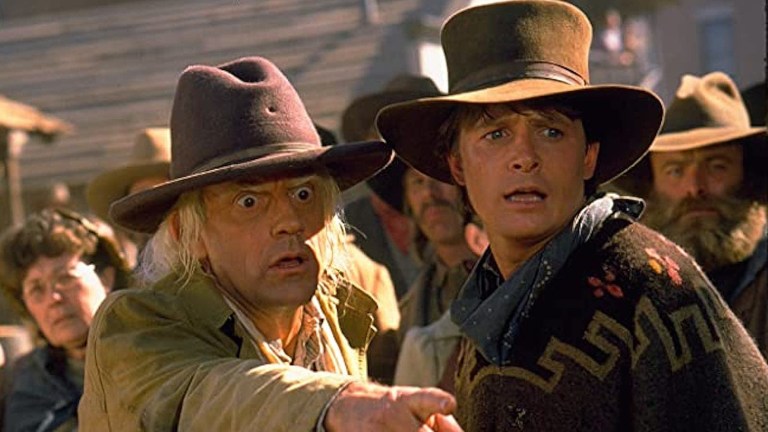Why Fan Response to the Back to the Future Sequels Changed
We explore how views on the Back to the Future sequels have changed with some insights from franchise co-creator Bob Gale.

In his original review for Back to the Future Part II, Roger Ebert (the Alpha and Omega of film criticism) called the movie “an exercise in goofiness, an excursion into various versions of the past and future that is so baffling that even the characters are constantly trying to explain it to each other.”
Although his review was largely a positive one, his sentiments echoed those of audiences who felt that Part II was an exercise in contrivance — one marked by baffling character choices (Marty’s sudden aversion to being called “chicken,” every line reading Thomas F. Wilson does as Griff, etc), strange plot details (ditching Jennifer from the story), and the overwhelming darkness of the alternative 1985 sequence, and a cliffhanger ending that sidelined the feel good elements of the first film for something strange and unfamiliar. Which is exactly what a sequel should do, i.e. The Empire Strikes Back.
Cut to 2020 and all of us are living in the Biff Tannen’s Pleasure Palace timeline, so the film seems much more plausible. More than that though, the subsequent 31 years since Back to the Future Part II’s release have allowed viewers to appreciate the movie on its own merits. It’s a weird flick to be sure, and one that has no interest in repeating what has gone before — except when it is literally doing so during the second visit to the Enchantment Under the Sea dance, and even then it is rewriting the rules of time travel films. Or, better still, making them up as it goes along, which results in Back to the Future Part II being an extraordinarily ambitious sequel even with its flaws.
The rug was further pulled out from audiences when it came time for Back to the Future Part III. Set almost entirely in 1885, the film primarily centered on Doc Brown’s budding romance with schoolteacher Clara Clayton (the great Mary Steenburgen). Whereas Part II feels like a kinetic, buzzy viewing experience, the concluding chapter is almost a character study that delves deep into who Doc and Marty really are. The concluding message that the future isn’t written yet, delivered by Doc as Clara and his twin boys, Jules and Verne, stand by felt both uplifting and an undoing of the point of having the sequels exist in the first place.
Three decades later and Back to the Future Part III feels like what sequels should aspire to be. It builds drama at a gentle pace, allowing character moments to take center stage. Writer Bob Gale and Director Robert Zemeckis knew this would be the last time we’d hang with these characters, and so they gave audiences moments that illustrated how important Marty and Doc are to each other. The action sequences remain dazzling, and the once divisive closing scene now feels like the best, most natural ending.
We recently talked with Bob Gale about how people responded to the sequels, and he gave us some insider knowledge into his thoughts on how the films were marketed and received.
“Remember, back in 1989, when Back to the Future Part II was released, we had no internet,” Gale says. “There was no such thing as social media, none of this stuff. If you wanted to find out what was coming to the movies, you had to go to the movies and watch the trailers. You had to wait for a TV spot. Maybe there was a movie magazine that would tell you something about an upcoming movie. But now, everybody knows everything about what movies are supposed to be coming out, pandemic excepted, of course. So we never know when anything’s going to come on now.”
And even though the first film made it clear a sequel was planned, keeping that going was a challenge for the second one.
“The biggest fight that I had with the president of Universal when we were planning the release of Part II is that I was adamant that I wanted to advertise this as part two of the three-part Back to the Future series, part two of the trilogy, and he didn’t want to do that,” Gale says. “He just wanted to say, ‘This is part two. Let them find out about part three later.'”
But ultimately, it was the memory of one of the great sequels of all time that convinced Gale what the right thing to do was.
“I remember walking out of the screening of [The Empire Strikes Back] thinking, ‘What the hell kind of ending is this? Han Solo’s in carbon freeze. That’s no good. And what is that? What is that?'”
But you have to go back further for even more inspiration.
“Richard Lester had directed The Three Musketeers, the very best version of The Three Musketeers. At the end of The Three Musketeers, there’s a trailer for The Four Musketeers,” Gale says. “I remember sitting in the theater saying, ‘Oh my God, that movie was so good. And look at it, there’s going to be another one. And they’re showing me 45 seconds of it and it looks so great. I can’t wait. How am I going to wait a year to see you The Four Musketeers?’ So that really was what gave us the idea to put a trailer for Back to the Future III at the very end of Part II, because we wanted everybody to know, yeah, we’re leaving you on a cliffhanger, but there’s going to be a third one and it’s almost finished.”
But that still didn’t change the perception of Part II in the moment.
“I think that if we had promoted Part II more as a part of a trilogy, people would have been more accepting of Part III for what it was, and for Part II for what it was, because people were disappointed in Part II because of the ending,” he says. “There were a lot of people who said, ‘Oh, that’s a rip-off ending. I’m not even going to go bother to see Part III.’ Well, of course, now everybody knows there’s three Back to the Futures, right? You’re going to go buy the movie. You end up buying all three of them, so of course you’re going to watch all three of them. They’re all beautifully interwoven and the more you see them, the more you see how we set stuff up in each movie that pays off later on. So people really appreciate the trilogy as the way we always hoped that it would be appreciated.”
When watched back-to-back-to-back, the Back to the Future trilogy feels groundbreaking. Three films that explore different parts of Hill Valley’s history, with Marty and Doc front and center as your guide to the various time periods. While the sequels may not have been given the credit they initially deserved, that is no longer the case.
The three Back to the Future films are cultural touchstones, each with their own merits. Even as you read this someone is discovering these movies right now thanks to a new Ultimate Trilogy 4K release. And whatever the future holds for any of us, one thing that you can depend on is Marty and Doc’s adventures will remain delightful.
